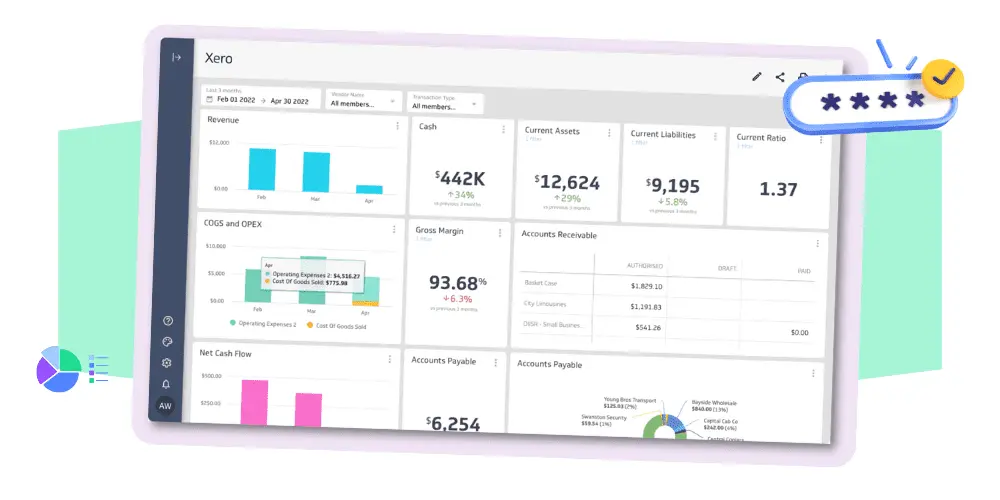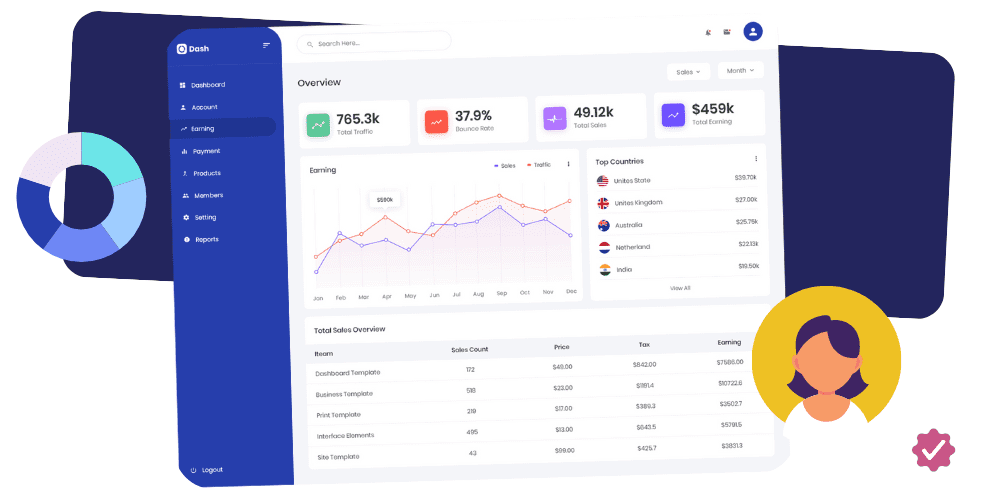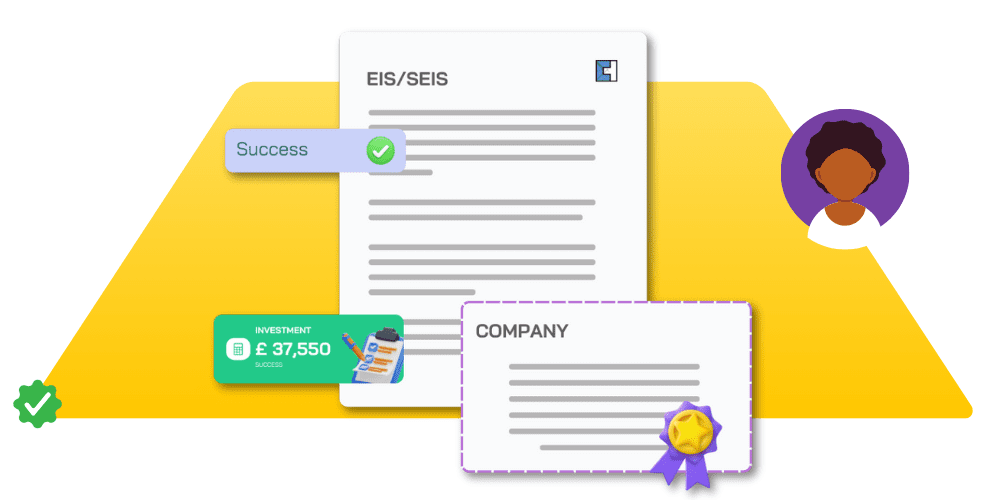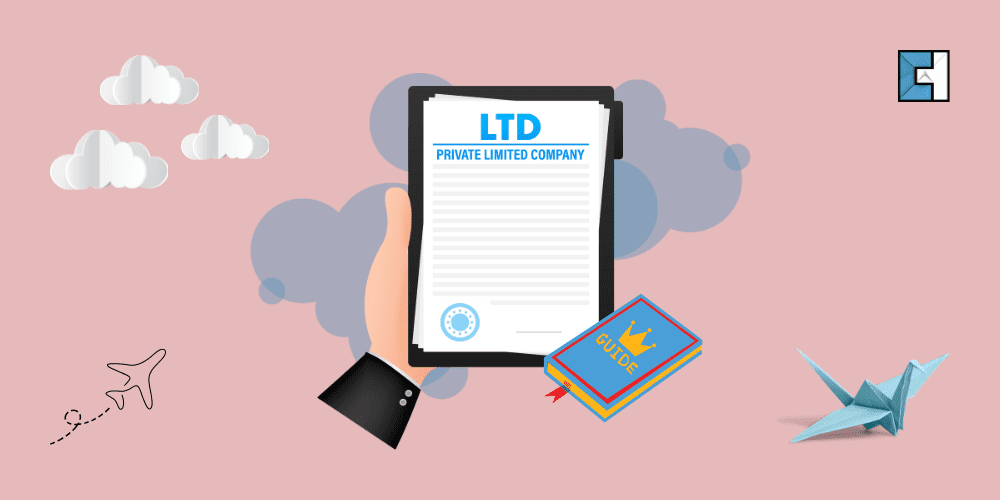If you are here reading this, congratulations; you’ve passed the most challenging step in setting up a business, taking up the initiative. Next comes an intricate decision-making process to decide what business structure you would like to take on for your business, which may depend on your financial affairs, business model, and goals.
If you are concerned with the liability of a business structure, you might want to look into a limited company structure. With the help of our specialist accountants for limited companies with years of experience, we have devised this comprehensive guide to help you better understand what you are getting into if you have decided or are planning to start your own limited company.
What Is A Limited Company? Limited Company Meaning
Limited can mean a lot of things, both negative and positive. However, when it comes to a limited company, it is called limited due to the limited liability the company promises to its owners. Being a separate legal entity apart from its owners, the company does not take on the liability of its owners.
Before moving on, let us take a moment to understand what limited liability signifies.
Limited liability means that the company owners are only liable to the extent of their invested capital. The company will be responsible for paying back any debts incurred by the limited company. In the company’s bankruptcy, the owners would not have to lose any personal assets, making it one of the most recommended and safe business structures.
Video: What Is A Limited Company?
Types Of A Limited Company
If you plan to set up a limited company, the next step is to figure out the structure model, as there are multiple models available for you to use based on your circumstances.
Here we shall look into these models in a little more detail to make the decision easier.
Private Limited Company (LTD)
More often than not, a business enthusiast or a group of businessmen would like to set up a Ltd company, due to limited liability, without having to transfer ownership to the general public. You can do this by setting up a private limited company, where the owners are one or a few selected people who have decided before the drafting of the company’s legal documentation. Setting up a limited company or an LTD Company is not without its advantages, such as creating a stronger brand image, limiting liability, and making it easy to create a division of ownership.
Public Limited Company (PLC)
A public limited company is where the investment opportunities are made public, which means that the company is required by law to be registered on the country’s stock exchange and make its shares accessible to the general public.
A PLC is set up when instigators of the business believe their company has potential and would like to pool a large sum of capital to be used by the company.
Public companies also have their own merits, such as significant capital raises, easy transfer of shares, and easier access to new investment opportunities. You can read more about the benefits of a PLC if you are interested.
Limited Liability Partnership (LLP)
A different approach to a limited company, a Limited Liability Partnership, is a hybrid form of a limited company and a partnership. This means it is more often formed amongst partners when you want the advantages of forming a partnership but want to keep exposure limited, like a limited company.
Setting up a limited liability company allows you to keep limited liability along with much more flexibility in terms of management and profit-sharing. You can also use a company as a partner in the LLP; this way, you can keep conducting your business through a company with an overall partnership structure. However, it is a costly method of setting up a business.
Key Difference Between Private And Public Limited
People often get confused about the difference between a Private Limited Company and a Public Limited Company. Let us look at the comparison below to finally put this confusion to rest and help you decide on the correct business structure for you. If you are unsure about what structure works best for your business objectives, you should ask this question of a professional adviser when shortlisting startup accounting services for your business.
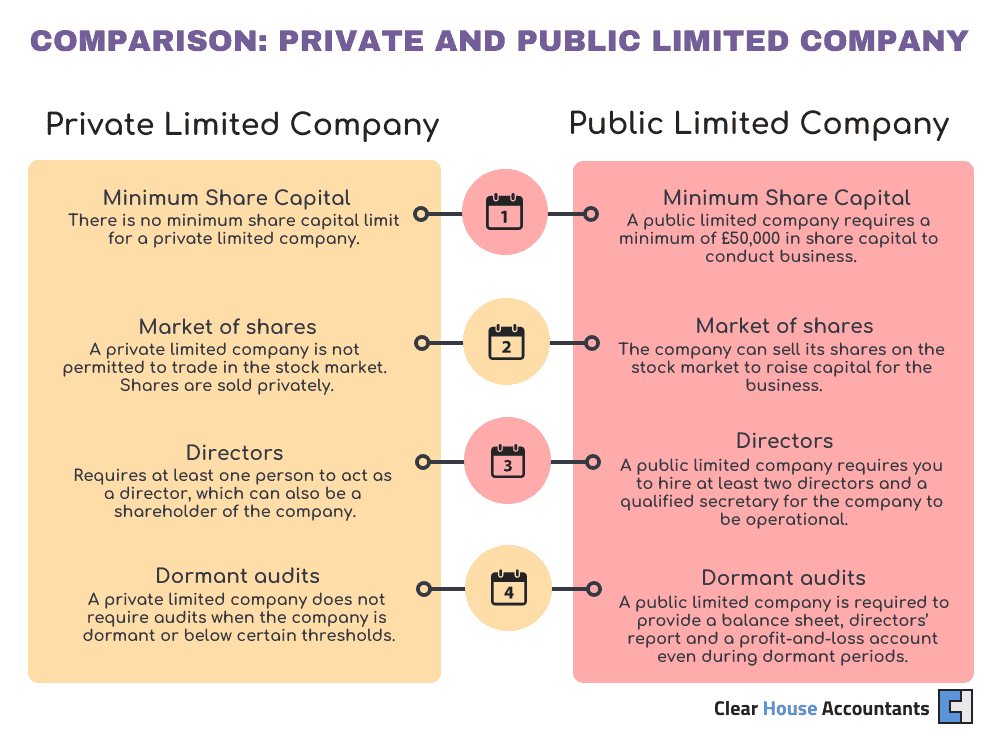
How To Form A Limited Company?
The process of forming a limited company might be a little more arduous than you may have thought, as there are a lot of legal formalities associated with the formation of a limited company.
Setting up a limited company is a step-by-step process that can indeed cause issues if you are not aware of the protocols. But fret not, for we are here to help you understand each step undertaken during the company formation process to ensure a seamless process.
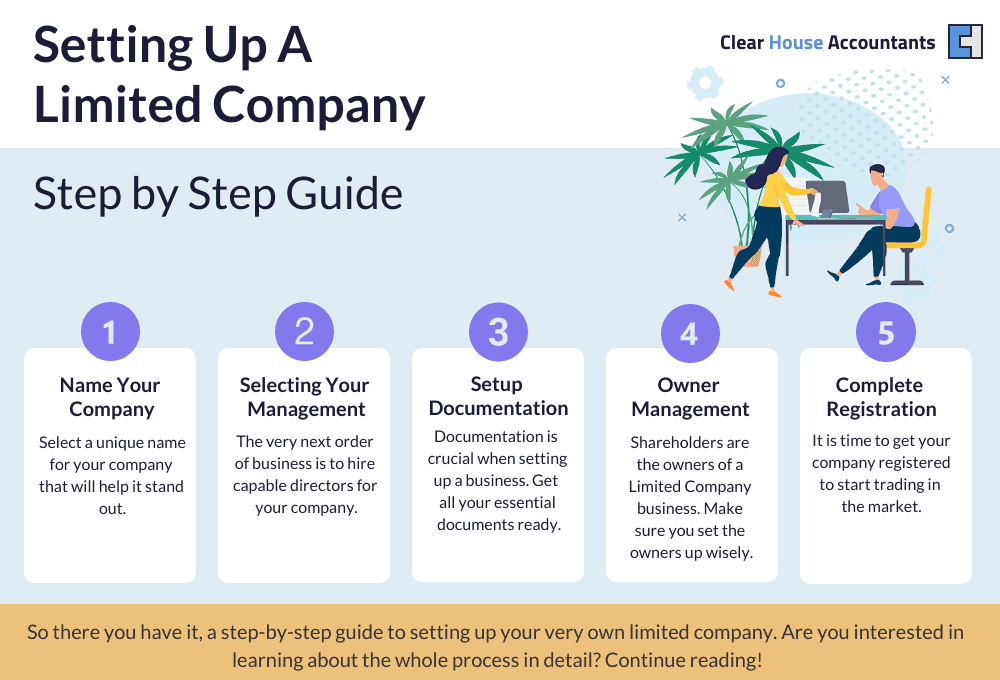
Step 1: Picking Out A Unique Name
Though it may not sound as important, your company’s name is the foundation of its legal existence and carries a particular significance with it. That is why, according to the laws and regulations of the UK, you need to pick out a unique company name to avoid any future conflicts and confusion with an existing business name or trademark.
Now, what qualifies as a unique name?
For instance, if you decided on the name CarsAreUs for your business, but there already exists a company with the name CarsRus, would your name qualify as a unique name?
The answer is No, as according to the Companies House, this qualifies as a “Same As” or “Too Like” name, which states that,
A name is not to be unique if the only difference between them is,
- Punctuations
- Addition of special characters such as “-”
- A phrase or word that is commonly used as a business name in the UK
- A character or symbol that is visually similar to a word in an existing company name, i.e. using “!” instead of “i” to differentiate.
- Spelling the name differently, but it sounds the same as an existing company name.
Step 2: Designated Directors
After picking out your company name, it is time to figure out who will be running the business and their core responsibilities. Depending on the legal structure of the business, there are different sets of rules, but the underlying regulations that company directors need to follow are:
- Follow the rules of the company as stated by the Articles of Association,
- Keeping track of the records and accounts of the company and reporting any discrepancies,
- Tell the company’s shareholders of any possible benefits they might receive due to the company’s transactions.
- Make sure all corporation tax responsibilities are taken care of.
In the case of a public limited company, you are required by law to hire at least two directors and a qualified secretary for your company to be operational.
Meanwhile, for a private company, you only need a single director who can be the business’s sole owner.
Step 3: Shareholder And Dividend Distributions
Shareholders are the actual owners of a company and are the main authority. Most limited companies are set up to be “Limited by shares”, meaning the shareholders have absolute control over the decision-making that goes on within the company. Therefore, it is essential for you to decide who your shareholders will be and how you will devise the dividend distribution, as it will later affect dividend extraction and dividend taxation.
According to Companies House, you must have at least one shareholder in the business who can also be a director of the business. In case you are the sole shareholder, you will be 100% the owner of the limited company.
The price of an individual share is decided by the directors and could be anything. In case of bankruptcy, the shareholders will have to pay for their shares in full.
At the start of your business, you issue a “statement of capital” providing information regarding your shares in detail. This helps in keeping track of the initial shareholders, also known as “subscribers”.
Step 4: Get Your Documents Sorted
The most aggravating part of setting up a company is getting the documentation sorted. Namely, the “Memorandum of Association” and the “Articles of Association” describe the initial information and workings of the company in detail.
Memorandum Of Association
It is a document that states the founding members have consensually gotten together to set up this company under the Companies Act 2006. The memorandum also states the number of shares held by the founding members and the minimum number of shares for each member.
Articles Of Association
The Articles of Association is a document that dictates the working and running procedures of the company. It is the governing document for a limited company. The articles of association include,
- Operational procedures of the company,
- Decision-making procedures,
- Owners rights,
- Management procedures,
- Responsibilities of the directors and staff,
- Transaction procedures.
Getting these documents ready used to be a real hassle while starting up a company, but with the help of online registrations, it has been made a lot easier, as the memorandum is automatically generated for you in case of online registration. You can find multiple Companies House-approved templates for the articles of association based on the nature of your company.
Step 5: Registration:
And finally, it is time to get your company registered with Companies House. This is a straightforward step but legally required if you want to open up a limited company.
To register your company, you would require at least 3 of the following documents to provide personal information about yourself and your shareholders.
- Place of birth
- Mother’s maiden name
- Father’s first name
- Phone number
- National insurance number
- Passport number
But how much does it cost to set up a limited company? To answer this simply, the registration process does come with a minuscule fee of £12, which can be paid via debit, credit card, or PayPal.
How Can You Register A Limited Company
You can use the following methods to register your company in the UK.
- Via Post
- Via An Agent
- Through 3rd Party Software
Registration Via Post
To get your limited company registered via post, head over to download the registration form, fill it out with the required details, and send it over. It may take up to 10 days to register your company via this post. In addition, you will have to pay £40 by cheque, charged directly through your own business bank account, as a registration fee addressed to Companies House.
Registration Via An Agent
Looking out for an agent or an accounting firm can help you get a long way in the registration process without a lot of hassle. Acquiring services from professional accountants can make it easier for you to take care of your business finances and pay attention to more important matters of your business whether you’re starting a new one or transferring an existing one to a limited company.

Registration Via 3rd Party Software
You can also get your company registered electronically with the help of approved 3rd party software by the Companies House. But make sure that you are aware of the business cost that comes with the use of such software, as all of them may charge you differently.
This method gets your limited company registered quickly, and the process can be made even faster if you are willing to take on a little more expenses.
Corporation Tax Laws For A Limited Company
As for the legal formalities, it is time to discuss the thing a businessman dreads the most. The tax you would have to pay as a limited company, especially if you also plan on being part of the board of directors, as they are responsible for filing and paying taxes.
To make it a little easier on you, with the help of our specialist tax accountants, we have curated a summary of all the taxes you would be required to pay if you decide to set up a limited company.
Corporation Tax (CT)
The company needs to register for corporation taxation within 3 months after its incorporation and within three months of being active. Being active is determined by the income being received for the services being provided through the company. HMRC will, on its own, send you a form to get registered. You will get a unique tax number required to file and pay your corporation tax; the filing of tax returns is required 12 months after a company’s year-end, and the tax is payable 9 months after the year-end.
It is imperative to register for corporation tax within the due date, as late registration may result in hefty fines or penalisation.
The current rate is set at 25% for the year 2023-2024. This rate applies to companies with annual profits in excess of £250,000, while the rate remained the same at 19% for companies with annual profits up to £50,000.
Value Added Tax (VAT)
In the UK, VAT is charged on most products, but what makes it different from other taxes is that the company itself collects it on behalf of the government.
You must register for VAT if your company’s annual turnover is higher than £85,000. This threshold is set and will remain the same until 31 March 2024
Learning all the rules and rates for VAT can be a little complicated; hence, we would advise you to read this in-depth guide for further details.
Company Car Tax
Applicable only in certain circumstances, however, it does have a significant impact on your annual earnings. It is important that we address the company car tax as part of the Limited Company conversation. Company car tax is a benefit-in-kind tax that applies if you are yourself provided with a company car as a director of a company or if you provide one to your employees as a benefit.
The rates of company car tax depend on the type of vehicle you provide your employees with and the CO2 emission rates of the vehicles.
National Insurance Contributions (NIC)
NIC is only applicable to individuals working on a salary at your business and not on dividends as of now. The NIC is collected by the employer and paid directly to HMRC.
There are the following payment slabs based on income thresholds,
- For class 1 employees, on the first £242 will pay nothing
- Class 1 employees with a salary between £242 and £967 per week are liable for 12%
- and NIC with 2% on any additional income above £967
It is essential to note that the first £ 5,000 of the employer’s NIC can be written off due to the employment allowance.
Income Tax (For Directors)
Being a director makes you an employee of the business, meaning you are liable for income tax. For the year 2023-2024, the personal allowance allowed is £12,570. This is the extent of earnings you can make tax-free annually.
For earnings above this, the rates of income taxes are,
- Basic Rate: on a taxable income of £12,571 to £50,270, the income tax rate is 20%.
- Higher Rate: on a taxable income of £50,271 to £125,140, the income tax rate is 40%.
- Basic Rate: on a taxable income of over £125,140, the income tax rate is 45%.
Dividend Tax
The dividend is paid to everyone who owns shares in the limited company, and the income earned by the dividend is taxable, but dividend tax works differently than other taxes.
You are also allowed tax-free dividend income, known as dividend allowance for 2023/24, which for the 6 April 2023 to 5 April 2024 is £1000, and it will reduce for the next year, 2024/25, to £500
Following are the rates of dividend taxes in regard to dividend income.
- Basic: £12,571 – £50,270; the rate of dividend tax is 8.75%
- Higher: £50,271 – £125,140, the rate of dividend tax is 33.75%
- Additional: £125,140 and above, the rate of dividend tax is 39.35%
But how is dividend tax different from traditional taxes? Well, let us explain with an example.
Suppose you earned an income of £25,570 and earned £4000 in dividends. This makes your total income £29,570. Taking off your personal allowance of £12,570, your taxable income would come down to £17,000.
So your basic tax payable would be,
- 20% on £13,000 as your income tax.
- No tax on £1,000 due to dividend allowance.
- 8.75% on £3000 dividend tax that is £262.50
- So, your total tax payable would be Income tax: £2,600 + £262.50 = £2,862.50.

How to Take Out Money From Your Limited Company?
If you are an owner of a limited company and act as a director, you are provided with a few options to withdraw money from your company. Here are some of the ways you can use to pay yourself and take some money home,
Salary
First and foremost, the easiest way to pay yourself out of the company’s account is to set up a salary for yourself. All you need to do is get your company registered with the HMRC and identify yourself as an employee of the company. However, you would be held personally liable to pay income tax, National Insurance contributions, and Employers’ National Insurance Contributions.
If you provide yourself with a salary, you can use the income allowance and avoid income taxes on £12,570 of your annual salary.
Dividends
More often than not, a company director is also a shareholder and holds onto quite a large part of the company. As a limited company requires at least one shareholder, the director can be that person. This is why paying dividends is considered one of the best ways of taking out money from your limited company, and it is a lot more tax-efficient than paying yourself a salary. First, however, you need to declare the dividend distribution and the distribution date as decided by the board of directors.
Dividends are the distribution of the company’s profits amongst the shareholders and directors after paying all the corporate tax liabilities.
Director’s Loan
A director can take out an amount from the business account to his personal account as a loan that needs to be repaid within 9 months of the limited company’s year-end, or else an additional tax charge would be applicable.
Similarly, a director can also lend finances to the business.
Reimbursement Of Expense
Any expense you have made from your personal account used “wholly and exclusively” for the purpose of business can be reimbursed from the business accounts. This will not only lower the tax liability of your business but also give your take-home money a little increment.
Why Should You Go For A Limited Company?
Everything has its pros and cons; similarly, a limited company comes with many advantages but is not void of disadvantages as well. However, it has been widely acclaimed that the benefits of setting up a limited company outweigh the disadvantages by quite a margin.

Let us look into these advantages and disadvantages in a little more detail.
Pros:
- Better tax planning: if you are a shareholder as well as the director of your company, you would be able to enjoy better tax planning opportunities.
- Separate Legal Entity: A business has its separate legal entity, which means that you will not be implicated by the actions and decisions of the business, but your liabilities as a director will remain.
- Limited Liability: One of the most significant advantages is the limited in the name of a limited company means limited liability that it offers. Not having to pay off the business debts of a business by using your personal assets is always a huge advantage. A limited company promises you that you will only be liable for the money you have invested and nothing more.
- Securing Investments: If you are a public limited company, you can always float new shares to secure more investments for the business after the original investment is exhausted. People tend to trust investing in a registered company much more than a sole trader.
- Transfer of Ownership: The process of transferring ownership in the case of a limited company is relatively straightforward. All you need to do is sell or gift your shares to the person you want to put in the position of an owner.
- Company Name Protection: The name of your limited company is legally protected by the compliance of Companies House.
- Hassle-Free Loans: Collaborating with a limited company gives a sense of confidence, and the company holds certain credibility, which might make it easier for an established company to secure loans for the business.
Cons
- Mandatory Incorporation: Setting up a limited company comes with mandatory incorporation with the Companies House, which may cause you to incur extra expenses and consume a lot of your time.
- Naming Restrictions: The Companies House has passed strict rules and regulations regarding the naming of your business, which can be quite annoying sometimes.
- Public Disclosure: Public limited companies are required to submit their annual reports and statements to the Companies House and HMRC, which are then posted on their websites for the eyes of the general public and their competitors.
- Records: Limited companies are required by the law to keep strict records, including but not limited to maintaining records of meetings amongst the board of directors and keeping notes of every decision made.
- Notifying Companies House For Everything: The limited company is required by law to inform Companies House of every change made in the company regarding management, capital, or flotation of new shares in the market.
- Withdrawals: As limited companies are separate legal entities, just like how their liabilities are theirs to bear, their profits are theirs to spend as well. Meaning an owner cannot willfully withdraw finances from the company for personal requirements. The owners can only withdraw in the form of dividends, which are issued in amounts relevant to the number of shares they hold.
The Right Time to Switch to a Limited Company
Usually, people start a new business as freelancers, contractors, or sole traders. It is much easier to set up and manage, considering the cost-effectiveness and the lower administrative burden. However, once they see a considerable increase in earnings, they plan to form a limited company.
It is commonly known that being a sole trader demands less compliance in terms of tax and accounting and is relatively simple. So, the right time to form a limited company would be when you need the additional benefits listed above, including limited liability and tax savings.
Closing A Limited Company
Closing off a business can mean many things, and they are not always negative in essence. Sometimes you want to close off a business because you realise you have a better plan for another business and could use the assets gained from the current business.
Striking Off A Limited Company
One of the cheapest ways of closing a limited company, striking off a company, is only applicable if your company is solvent and,
- Hasn’t sold or traded any shares or stocks in the past three months, at least.
- Hasn’t changed the company name in the past three months.
- It isn’t facing liquidation.
- Has no prior agreements with creditors regarding the closing of the company.
If your company meets all these criteria, you can apply to get your limited company struck off by applying through an application after letting your members, shareholders, creditors, employees, managers, and directors who have yet to sign the application.
But what if your company does not meet these conditions? In this case, unfortunately, you would have to face liquidation.
Liquidation
Liquidation means winding up a limited company to pay off the company’s debts by the sale of the assets owned by the company.
This, most often, happens in the case of insolvency, where a limited company is unable to raise funds to pay off its business debts. But it can also be initiated by shareholders if 75% of shareholders agree to wind up the company.
If the company has decided to be “wound up”, there are certain formalities that you need to take care of, which are,
- The hiring of an authorised insolvency lawyer who acts as a liquidator and takes charge of the limited company’s liquidation.
- Send the notice of resolution to the Companies House within 15 days.
- Advertise your resolution in The Gazette within 14 days.
Conclusion
Setting up a business is not as complicated as people sometimes make it sound, but it does require scrutiny, dedication, and patience. Now that you know all the basics of a limited company, you can start, but it is advisable to take it slow and make sure you make the right decisions with the right help and save up on accountancy fees. If set up right, a limited company might be what you need to set yourself up for financial success.
Additional Resource
Should a company register for VAT, even if not required?
Whether you need to register the company for VAT may depend on the business. Even if it’s not mandatory for your business, you can still benefit from voluntary VAT registration.
When should a company register for PAYE?
If your company is paying any salaries, including the director’s salary, you need to register the company for PAYE to stay compliant.
When should a company file a company tax return?
Annually, if a company is registered for corporation tax, it needs to submit a company tax return by the deadline given by HMRC. These taxes need to be filed every year.
















